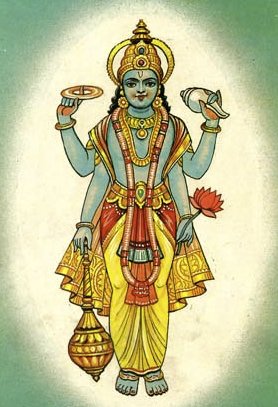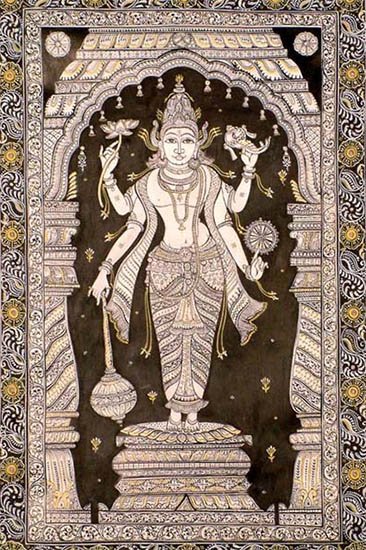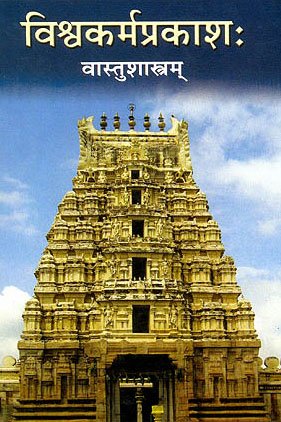Mridanga, Mṛdaṅga, Mṛdaṃga, Mridamga: 30 definitions
Introduction:
Mridanga means something in Buddhism, Pali, Hinduism, Sanskrit, Jainism, Prakrit, the history of ancient India, Marathi, Hindi. If you want to know the exact meaning, history, etymology or English translation of this term then check out the descriptions on this page. Add your comment or reference to a book if you want to contribute to this summary article.
The Sanskrit terms Mṛdaṅga and Mṛdaṃga can be transliterated into English as Mrdanga or Mridanga or Mrdamga or Mridamga, using the IAST transliteration scheme (?).
In Hinduism
Purana and Itihasa (epic history)
Source: Google Books: Cultural History from the Vāyu PurānaMṛdaṅga (मृदङ्ग): a Musical Instrument.—It is not mentioned in the Ṛgveda. The Jātakas mention Mūtiṅgā probably the same as Mṛdaṅga. But Kauṭilya knows it well. The Rāmāyaṇa mentions Mṛdaṅga as also the Mahābhārata. In later literature we find the origin of this instrument atributed to Brahmā made to serve as an accompaniment to the dance of Śiva in honour of his victory over the three cities and that Gaṇeśa first played upon it.
The Vāyu-purāṇa associates this instrument with the Kurus who used it in their sports for entertainment. The information occurs not in the genealogical accounts but in the chapters on geography. Of the late story of its origin the Vāyu knows nothing. The Rāmāyaṇa tells us that it was also used in war but there is no such reference in the Vāyu.
Source: archive.org: Shiva Purana - English TranslationMṛdaṅga (मृदङ्ग) refers to a kind of drum (musical instrument), according to the Śivapurāṇa 2.2.22. Accordingly as Brahmā narrated to Nārada:—“[...] On the top of the mountain near the city of Himālaya (śailarājapura), Śiva sported about for a long time in the company of Satī. [...] Many kinds of semid-ivine beings the Aśvamukhas, the Siddhas, the Apsaras, the Guhyakas, etc. roamed there. Their women-folk, the Vidyādharīs, the Kinnarīs and the mountain lasses played about here and there. The celestial damsels played on their lutes, tabours and drums (mṛdaṅga) and danced with enthusiasm”.
Source: Cologne Digital Sanskrit Dictionaries: The Purana IndexMṛdaṅga (मृदङ्ग).—A musical instrument.*
- * Vāyu-purāṇa 45. 40.

The Purana (पुराण, purāṇas) refers to Sanskrit literature preserving ancient India’s vast cultural history, including historical legends, religious ceremonies, various arts and sciences. The eighteen mahapuranas total over 400,000 shlokas (metrical couplets) and date to at least several centuries BCE.
Vaishnavism (Vaishava dharma)
Source: ISKCON Press: GlossaryMṛdaṅga (मृदङ्ग).—A two-headed clay drum used for kīrtana performances and congregational chanting.
Source: Pure Bhakti: Arcana-dipika - 3rd EditionMṛdaṅga (मृदङ्ग) refers to:—A clay drum, used traditionally by Gauḍīya Vaiṣṇavas during the performance of bhajana and kīrtana. muhūrta–forty-eight minutes. (cf. Glossary page from Arcana-dīpikā).
Source: Pure Bhakti: Brhad BhagavatamrtamMṛdaṅga (मृदङ्ग) refers to:—A two-headed clay drum made for the saṅkīrtana of Śrī Caitanya Mahāprabhu. (cf. Glossary page from Śrī Bṛhad-bhāgavatāmṛta).

Vaishnava (वैष्णव, vaiṣṇava) or vaishnavism (vaiṣṇavism) represents a tradition of Hinduism worshipping Vishnu as the supreme Lord. Similar to the Shaktism and Shaivism traditions, Vaishnavism also developed as an individual movement, famous for its exposition of the dashavatara (‘ten avatars of Vishnu’).
Natyashastra (theatrics and dramaturgy)
Source: Wisdom Library: Nāṭya-śāstraMṛdaṅga (मृदङ्ग) refers to one of the major types of drums (puṣkara) according to the Nāṭyaśāstra chapter 33. Accordingly, “When the playing of Mṛdaṅgas follow a performance, it is Anuvādya. When the Mṛdaṅgas are played simultaneously with a performance, it is Samavādita”. Mṛdaṅga is a kind of earthen drum still in use in Bengal among the singers of Vaiṣṇava kīrtana.
According to verse 33.242-244.—“Three are the shapes of mṛdaṅgas. In shape they are like myrobalan, barley and cow’s tail. The mṛdaṅga and the āṅkika should be three tālas and a half long, and their face should be twelve fingers in diametre”.
And according to verse 33.272-274, “Mṛdaṅgas are so called because of being made of mṛt (earth)”

Natyashastra (नाट्यशास्त्र, nāṭyaśāstra) refers to both the ancient Indian tradition (shastra) of performing arts, (natya—theatrics, drama, dance, music), as well as the name of a Sanskrit work dealing with these subjects. It also teaches the rules for composing Dramatic plays (nataka), construction and performance of Theater, and Poetic works (kavya).
Shaivism (Shaiva philosophy)
Source: academia.edu: The Yoga of the MālinīvijayottaratantraMṛdaṅga (मृदङ्ग) refers to one of the ten kinds of sounds (śabda) according to the Haṃsa-upaniṣad.

Shaiva (शैव, śaiva) or Shaivism (śaivism) represents a tradition of Hinduism worshiping Shiva as the supreme being. Closely related to Shaktism, Shaiva literature includes a range of scriptures, including Tantras, while the root of this tradition may be traced back to the ancient Vedas.
Shilpashastra (iconography)
Source: Shodhganga: The significance of the mūla-beras (śilpa)Mṛdaṅga refers to a type of “drum”, representing one of the several “attributes” (āyudha) or “accessories” of a detiy commonly seen depicted in Hindu iconography, defined according to texts dealing with śilpa (arts and crafs), known as śilpaśāstras.—The śilpa texts have classified the various accessories under the broad heading of āyudha or karuvi (implement), including even flowers, animals, and musical instruments. The musical instruments held in the hands of deities are, for example, Mṛdaṅga.

Shilpashastra (शिल्पशास्त्र, śilpaśāstra) represents the ancient Indian science (shastra) of creative arts (shilpa) such as sculpture, iconography and painting. Closely related to Vastushastra (architecture), they often share the same literature.
Jyotisha (astronomy and astrology)
Source: Wisdom Library: Brihat Samhita by VarahamihiraMṛdaṅga (मृदङ्ग) or Mṛdaṅgarūpa refers to a particular shape of the moon, according to the Bṛhatsaṃhitā (chapter 4), an encyclopedic Sanskrit work written by Varāhamihira mainly focusing on the science of ancient Indian astronomy astronomy (Jyotiṣa).—Accordingly, “Having thus described the shape of the moon we next proceed to describe her size (generally): if the moon should appear small there will be famine, and if big, prosperity, in the land. If the middle of the moon (candra) should appear small, there will be hunger in the land and princes will be afflicted with cares. If the middle should appear big [i.e., mṛdaṅga-rūpa] she will cause prosperity and plenty”.

Jyotisha (ज्योतिष, jyotiṣa or jyotish) refers to ‘astronomy’ or “Vedic astrology” and represents the fifth of the six Vedangas (additional sciences to be studied along with the Vedas). Jyotisha concerns itself with the study and prediction of the movements of celestial bodies, in order to calculate the auspicious time for rituals and ceremonies.
Vastushastra (architecture)
Source: Shodhganga: Elements of Art and Architecture in the Trtiyakhanda of the Visnudharmottarapurana (vastu)Mṛdaṅga (मृदङ्ग) refers to one of the hundred types of Temples (in ancient Indian architecture), according to the Viṣṇudharmottarapurāṇa, an ancient Sanskrit text which (being encyclopedic in nature) deals with a variety of cultural topics such as arts, architecture, music, grammar and astronomy.—It is quite difficult to say about a definite number of varieties of Hindu temples but in the Viṣṇudharmottarapurāṇa hundred varieties of temples have been enumerated. For example, Mṛdaṅga. These temples are classified according to the particular shape, amount of storeys and other common elements, such as the number of pavilions, doors and roofs. [...] The Viṣṇudharmottarapurāṇa relates that the temple named Mṛdaṅga should be constructed in the shape of a drum.

Vastushastra (वास्तुशास्त्र, vāstuśāstra) refers to the ancient Indian science (shastra) of architecture (vastu), dealing with topics such architecture, sculpture, town-building, fort building and various other constructions. Vastu also deals with the philosophy of the architectural relation with the cosmic universe.
In Buddhism
Tibetan Buddhism (Vajrayana or tantric Buddhism)
Source: OSU Press: Cakrasamvara SamadhiMṛdaṃga (मृदंग) refers to the “(vajra) drum” [i.e., oṃ vajramṛdaṃge hrīṃ], according to the Guru Mandala Worship (maṇḍalārcana) ritual often performed in combination with the Cakrasaṃvara Samādhi, which refers to the primary pūjā and sādhanā practice of Newah Mahāyāna-Vajrayāna Buddhists in Nepal.

Tibetan Buddhism includes schools such as Nyingma, Kadampa, Kagyu and Gelug. Their primary canon of literature is divided in two broad categories: The Kangyur, which consists of Buddha’s words, and the Tengyur, which includes commentaries from various sources. Esotericism and tantra techniques (vajrayāna) are collected indepently.
In Jainism
General definition (in Jainism)
Source: The University of Sydney: A study of the Twelve ReflectionsMṛdaṅga (मृदङ्ग) refers to a “drum”, according to the 11th century Jñānārṇava, a treatise on Jain Yoga in roughly 2200 Sanskrit verses composed by Śubhacandra.—Accordingly, “That [cosmos] is not at all produced by anyone, not at all sustained by anyone, so also not destroyed by anyone. Nevertheless, that exists by itself without support in the atmosphere. [...] It is the shape of a cane stool in the lower region, like a cymbal in the middle and it is like a drum (mṛdaṅga-sadṛśa) on the top. Thus, that consists of three parts”.
Source: Singhi Jain Series: Ratnaprabha-suri’s Kuvalayamala-kathaMṛdaṅga (मृदङ्ग) refers to one of the various attributes held by the Eight auspicious Girls (representing the eight celestial nymphs of Indra’s heaven) (also: aṣṭakanyā), according to Uddyotanasūri in his 8th-century Kuvalayamālā (a Prakrit Campū, similar to Kāvya poetry).—Page 93.17-8: There is a list of Eight auspicious girls holding respectively sprouted water-jars, fan-palm, fly-whisk, parasol, mirror, mṛdaṅga, harp, drum and cloth and ornaments. These were regarded as eight celestial nymphs of Indra’s heaven and frequently referred in literature as aṣṭakanyā or sabhā-kanyā. [...]

Jainism is an Indian religion of Dharma whose doctrine revolves around harmlessness (ahimsa) towards every living being. The two major branches (Digambara and Svetambara) of Jainism stimulate self-control (or, shramana, ‘self-reliance’) and spiritual development through a path of peace for the soul to progess to the ultimate goal.
India history and geography
Source: archive.org: Trisastisalakapurusacaritra (history)Mṛdaṅga (मृदङ्ग) refers to the kind of Indian drum in most general use. It is barrel shaped with parchment covering on both ends. One end is moistened with a kind of black rice-paste which is left on permanently. The other end is covered with a white paste which is renewed each time.
Source: What is India: Inscriptions of the VākāṭakasMṛdaṅga (मृदङ्ग) refers to the “tabor” which was commonly seen during the reign of the Vākāṭakas (mid-3rd century CE).—Ajaṇṭā paintings give us a clear idea of the costume and jewellery worn by men and women in Vidarbha in the age of the Vākāṭakas. [...] Among musical instruments are noticed tabors (mṛdaṅgas), conches, symbals, flutes and lutes with one or more strings. The tabor, while being played upon, was suspended from the neck.

The history of India traces the identification of countries, villages, towns and other regions of India, as well as mythology, zoology, royal dynasties, rulers, tribes, local festivities and traditions and regional languages. Ancient India enjoyed religious freedom and encourages the path of Dharma, a concept common to Buddhism, Hinduism, and Jainism.
Languages of India and abroad
Marathi-English dictionary
Source: DDSA: The Molesworth Marathi and English Dictionarymṛdaṅga (मृदंग).—m (S) A sort of tabor. Pr. mṛdaṅgāsa māra dōhōkaḍūna.
Source: DDSA: The Aryabhusan school dictionary, Marathi-Englishmṛdaṅga (मृदंग).—m A sort of tabor.
Marathi is an Indo-European language having over 70 million native speakers people in (predominantly) Maharashtra India. Marathi, like many other Indo-Aryan languages, evolved from early forms of Prakrit, which itself is a subset of Sanskrit, one of the most ancient languages of the world.
Sanskrit dictionary
Source: DDSA: The practical Sanskrit-English dictionaryMṛdaṅga (मृदङ्ग).—[mṛd-aṅgac kiñca]
1) A kind of drum or tabor; वीणावेणुमृदङ्गानि पुरं प्रविशति प्रभौ (vīṇāveṇumṛdaṅgāni puraṃ praviśati prabhau) Bhāgavata 1.5.38.
2) A bamboo-cane.
3) Noise.
Derivable forms: mṛdaṅgaḥ (मृदङ्गः).
Source: Cologne Digital Sanskrit Dictionaries: Shabda-Sagara Sanskrit-English DictionaryMṛdaṅga (मृदङ्ग).—m.
(-ṅgaḥ) 1. A tobour, a small drum. 2. A double drum. 3. A sound, a noise. 4. A bamboo-cane. E. mṛd to be trampled on, to be beat, Unadi aff. aṅgac; also with kan added mṛdaṅgaka .
Source: Cologne Digital Sanskrit Dictionaries: Benfey Sanskrit-English DictionaryMṛdaṅga (मृदङ्ग).—probably mṛd + a + m-ga, m. 1. A tabour, [Uttara Rāmacarita, 2. ed. Calc., 1862.] 154, 9; a small drum, [Pañcatantra] 20, 8. 2. A sound. 3. Bambu.
Source: Cologne Digital Sanskrit Dictionaries: Cappeller Sanskrit-English DictionaryMṛdaṅga (मृदङ्ग).—[masculine] a kind of drum.
Source: Cologne Digital Sanskrit Dictionaries: Monier-Williams Sanskrit-English Dictionary1) Mṛdaṃga (मृदंग):—[from mṛd] m. ([probably] [from] mṛdam + ga, ‘going about while being beaten’; cf. mardala and, [Uṇādi-sūtra i, 120 [Scholiast or Commentator]]) a kind of drum, tabour, [Mahābhārata; Kāvya literature] etc.
2) [v.s. ...] noise, din, [cf. Lexicographers, esp. such as amarasiṃha, halāyudha, hemacandra, etc.]
3) [v.s. ...] a bamboo cane, [cf. Lexicographers, esp. such as amarasiṃha, halāyudha, hemacandra, etc.]
Source: Cologne Digital Sanskrit Dictionaries: Monier-Williams Sanskrit-English DictionaryMṛdaṅga (मृदङ्ग):—etc. See mṛdaṃga, [column]2.
Source: Cologne Digital Sanskrit Dictionaries: Yates Sanskrit-English DictionaryMṛdaṅga (मृदङ्ग):—(ṅgaḥ) 1. m. A tabour; a double drum; a noise; a bambu.
Source: DDSA: Paia-sadda-mahannavo; a comprehensive Prakrit Hindi dictionary (S)Mṛdaṅga (मृदङ्ग) in the Sanskrit language is related to the Prakrit word: Mayaṃga.
[Sanskrit to German]
Sanskrit, also spelled संस्कृतम् (saṃskṛtam), is an ancient language of India commonly seen as the grandmother of the Indo-European language family (even English!). Closely allied with Prakrit and Pali, Sanskrit is more exhaustive in both grammar and terms and has the most extensive collection of literature in the world, greatly surpassing its sister-languages Greek and Latin.
Hindi dictionary
Source: DDSA: A practical Hindi-English dictionaryMṛdaṃga (मृदंग) [Also spelled mradang]:—(nf) a drum-like Indian musical percussion instrument; ~[giyā] one who plays on a [mṛdaṃga].
...
Kannada-English dictionary
Source: Alar: Kannada-English corpusMṛdaṃga (ಮೃದಂಗ):—[noun] a kind of hollow cylindrical percussion instrument, with a memberane stretched tightly over both the ends played by beating with both the hands.
Kannada is a Dravidian language (as opposed to the Indo-European language family) mainly spoken in the southwestern region of India.
See also (Relevant definitions)
Starts with: Mridamgavadaka, Mridangaka, Mridangakara, Mridangaketu, Mridangapanava, Mridangapha, Mridangaphala, Mridangaphalini, Mridangarupa, Mridangavada.
Ends with: Alingimridanga, Ankimridanga, Kundamridanga, Mangalyamridanga, Urdhvakamridanga, Vajramridanga.
Full-text (+205): Mridangaphala, Mayamga, Mradang, Mridangi, Gumatha, Ghadavashi, Mridamgaphalini, Mridamgavadaka, Chinnaviddha, Mridamgaphala, Avakirna, Muraja, Mardamgika, Alingika, Mridamgi, Mangalyamridamga, Saindhava, Makunda, Anuviddha, Drum.
Relevant text
Search found 52 books and stories containing Mridanga, Mṛdaṅga, Mṛdaṃga, Mṛdanga, Mrdanga, Mrdamga, Mridamga; (plurals include: Mridangas, Mṛdaṅgas, Mṛdaṃgas, Mṛdangas, Mrdangas, Mrdamgas, Mridamgas). You can also click to the full overview containing English textual excerpts. Below are direct links for the most relevant articles:
Garga Samhita (English) (by Danavir Goswami)
Verse 2.24.15 < [Chapter 24 - The Story of Asuri Muni in the Rāsa-dance Pastime]
Verse 2.17.12 < [Chapter 17 - The Meeting of Śrī Rādhā-Kṛṣṇa]
Verse 3.1.21 < [Chapter 1 - The Worship of Śrī Girirāja]
Srila Gurudeva (The Supreme Treasure) (by Swami Bhaktivedanta Madhava Maharaja)
The Dancing of Bhakti Prajñāna Keśava Gosvāmī Mahārāja < [Chapter 1.4 - Life in the Maṭha]
First Letter < [Chapter 2.9 - Letters From America]
Third Letter < [Chapter 2.9 - Letters From America]
Chaitanya Bhagavata (by Bhumipati Dāsa)
Verse 1.3.33 < [Chapter 3 - Calculation of the Lord’s Horoscope]
Verse 2.23.90 < [Chapter 23 - Wandering about Navadvīpa On the Day the Lord Delivered the Kazi]
Verse 2.23.101 < [Chapter 23 - Wandering about Navadvīpa On the Day the Lord Delivered the Kazi]
Natyashastra (English) (by Bharata-muni)
Chapter XXXIII - On Covered Instruments (avanaddha)
Part 2 - The Ancient Indian Theory and Practice of Music < [Introduction, Part 2]
Hari-bhakti-kalpa-latikā (by Sarasvati Thkura)
Text 7 < [Second Stabaka]
Shrimad Bhagavad-gita (by Narayana Gosvami)
Verse 1.13 < [Chapter 1 - Sainya-Darśana (Observing the Armies)]